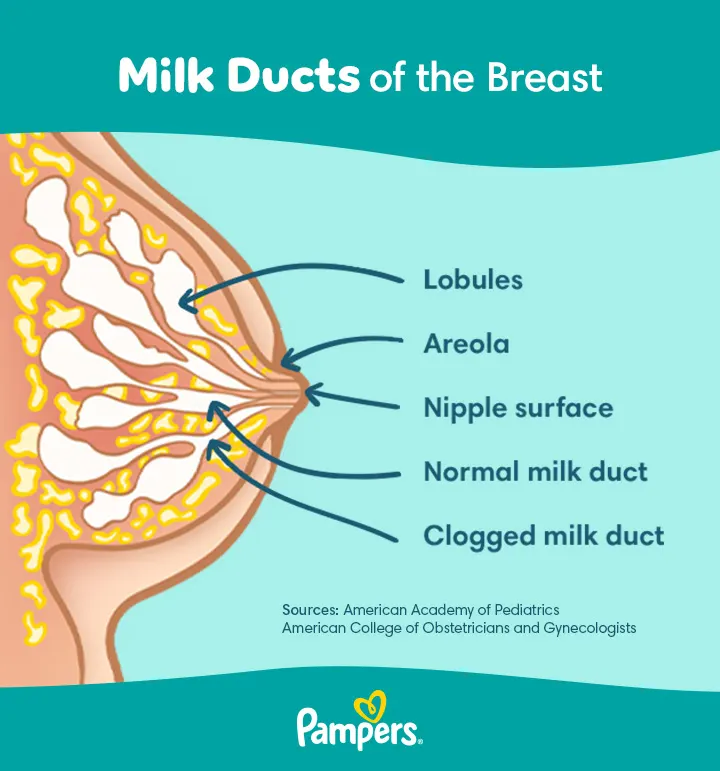
How to Relieve Blocked Milk Ducts
There are a number of reasons you may experience breast pain while you’re breastfeeding. One of these is a blocked milk duct, which commonly occurs among breastfeeding mothers. Read below to find out why clogged milk ducts occur, what the symptoms are, and how it can be treated and prevented.
What Is a Blocked Milk Duct?
While breastfeeding your baby you may experience a blocked milk duct from time to time. But what exactly does this involve?
The glands that produce milk in your breast are divided into segments, rather like an orange. Narrow tubes called lobules carry the milk from each segment to your nipple. Each nipple has 15 to 25 tiny openings called pores, but only about 6 or 7 are open to release milk during nursing.
Sometimes, if one of the segments isn’t drained properly during a feed, you may develop a blocked duct, which may be a source of pain. This can happen if your baby isn’t properly latching onto your breast during nursing, or if your baby has tongue-tie.
What Are the Symptoms of a Clogged Milk Duct?
If you experience any of the following symptoms, you may have a blocked milk duct:
You may feel a small, tender lump in your breast
The area where the lump is may be red or darker
The lump may feel soft, dense, or tender
Your breasts may feel full even after nursing your little one.
What Does a Blocked Milk Duct Look Like/Feel Like?
You may not be able to tell whether you have a clogged milk duct just by looking at your breast. It generally boils down to a combination of how your breast looks and feels. If an area of the breast is red and irritated and feels soft, tender, or dense when touched, you may have a blocked milk duct.
What Causes a Clogged Milk Duct?
There are a number of reasons that can lead to a blocked milk duct. A common cause is tight clothing. If your top, bra, or seatbelt is too tight, this can irritate your breast tissue. Wear a well-fitting breastfeeding bra that doesn’t restrict your breasts to prevent blocked ducts. Awkward sleeping positions can have a similar effect.
Breast engorgement is another factor that can contribute to clogged milk ducts. If you make more milk that your baby needs, your breasts may become overfilled with milk, otherwise referred to as engorgement. It’s important to treat engorgement as soon as possible, as it can result in mastitis. If you notice your breasts are still engorged after six to eight weeks, you should contact your midwife or health visitor for advice or treatment.
How Do You Get Rid Of A Blocked Milk Duct?
There are a number of things you can do to treat, clear, and unclog a clogged milk duct:
Start feeding frequently from the affected breast
Carry on breastfeeding to lower the risk of the blockage developing into mastitis
If you were thinking of stopping breastfeeding at this point, it’s important to first clear the blockage
Make sure your baby is properly latched by placing their chin point towards the lump so they can feed from that part of the breast, if possible
Try changing up your baby’s feeding position
Avoid wearing tight clothes or bras to ensure your milk can flow freely from every part of your breast
Use warm flannels or take a warm shower to encourage the flow
Gently massage the lump towards your nipple while your little one feeds
If your baby falls asleep quickly, or is not feeding effectively, express milk after nursing
There are no studies to prove this, but many women find it helpful to try breaking up the blockage using an electric toothbrush. The vibrations are said to be helpful.
It may be relieving to put a warm compress on your breast
Get plenty of rest
You can try taking paracetamol or ibuprofen, but be sure to check with your doctor or midwife first
If you experience any body aches or a fever along with the clogged milk duct, seek advice from your doctor or midwife, as this may indicate that your blocked milk duct has developed into mastitis.
If you’re unsure what’s causing breast pain or tenderness, speak to your doctor or midwife.
How Can You Prevent Blocked Milk Ducts?
There are a number of things you can do to prevent clogged milk ducts. We have also explored some of these tips above, as these prevention strategies can also help clear a blocked milk duct:
Avoid restrictive or tight-fitting clothing like tight tops, tight bras, or underwired bras to minimise the pressure placed on your breasts. You may even decide to not wear a bra for a while or wear a larger cup size.
Frequently feed from the affected breast and change up your baby’s position when nursing
Use warm flannels or a warm shower to encourage the flow
Ensure your baby is properly latched (one sign of a good latch is that it’s slightly asymmetrical—your baby has more of your areola in their mouth on their lower lip than their upper lip with your nipple pointing toward the roof of their mouth).
If you’re having problems with latching, experience reoccurring bouts of clogged milk ducts, or if you have any questions related to breastfeeding, reach out to your midwife or doctor personalised help and guidance.
Can You Pop a Blocked Milk Duct?
You will not be able to squeeze the clogged milk duct, but instead can gently unclog the nipple. If you notice any dried milk on your nipples, or the nipples pore is clogged, use a warm flannel or compress to treat the affected nipple. Then try expressing milk by hand to loosen and expel the milk behind the blockage.
Gently massaging the area can also help. It’s best to massage the affected breast starting from the area where you feel the lump (the area of the clogged milk duct) toward the nipple. This helps move the blockage toward the nipple so that it can be expelled. You can do this before you breastfeed your baby, while breastfeeding, or when you’re taking a bath or a shower.
Does Ibuprofen Help Clogged Milk Ducts?
Pain killers like ibuprofen and paracetamol can be handy ways to help manage the pain caused by a clogged milk duct. To stay on the safe side, speak to your doctor or midwife before taking any pain medicine.
F&QS AT A GLANCE
If you breastfeed your little one, you may experience a clogged milk duct from time to time. You can usually tell that a duct is blocked if you find a small red, tender lump on your breast, which may be accompanied by a certain amount of pain.
The Bottom Line
Breastfeeding women may experience blocked milk ducts for a variety of reasons: from incomplete drainage when feeding your little one to wearing excessively tight clothing. Luckily, there are a number of things you can do to prevent and/or unclog a blocked milk duct. Try feeding more frequently, adopting different nursing positions and making sure your baby feeds as long as they can until the breast is emptied of milk. If you baby doesn’t feed as long as you need them to, you can always express or pump the remaining milk.
The pain caused by clogged milk ducts certainly isn’t a walk in the park, but with the right steps, you can remedy the issue and prevent future clogged milk ducts. If you need any further guidance, get in touch with your midwife or doctor.
How we wrote this article
The information in this article is based on the expert advice found in trusted medical and government sources, such as the National Health Service (NHS). You can find a full list of sources used for this article below. The content on this page should not replace professional medical advice. Always consult medical professionals for full diagnosis and treatment.
Read more about Baby
Related Articles
Join Pampers Club and get:














